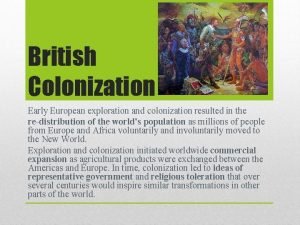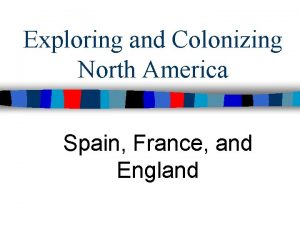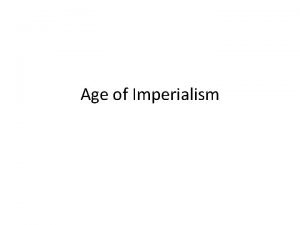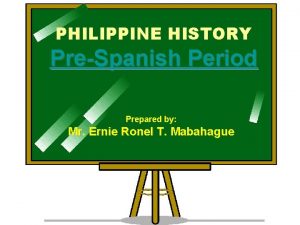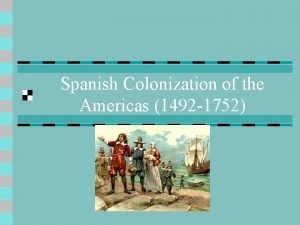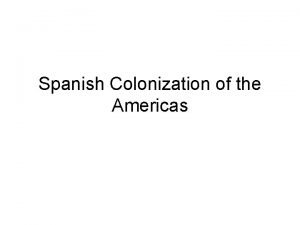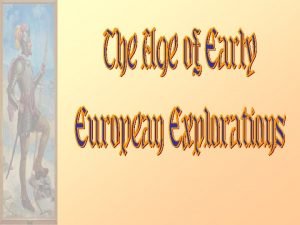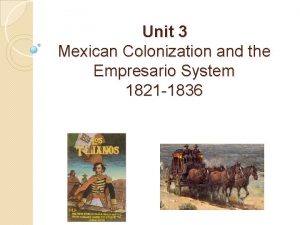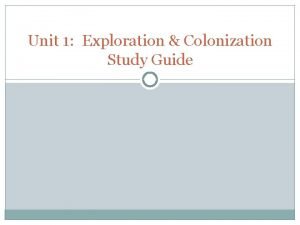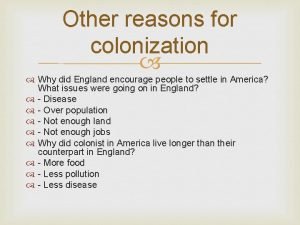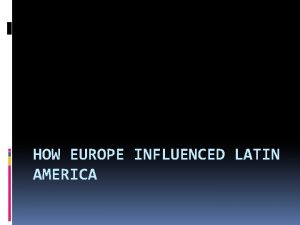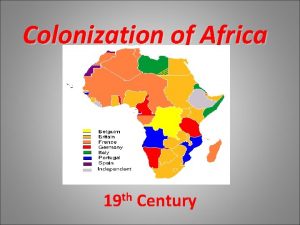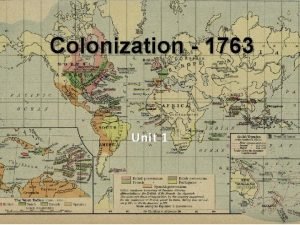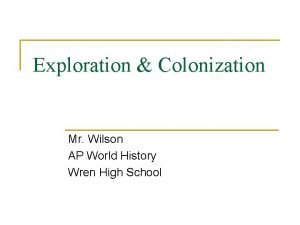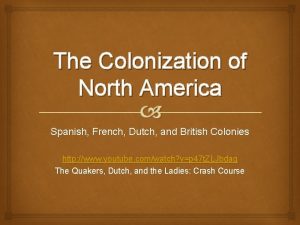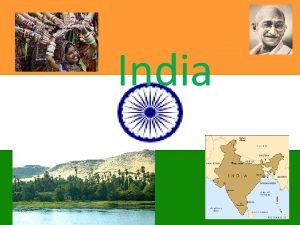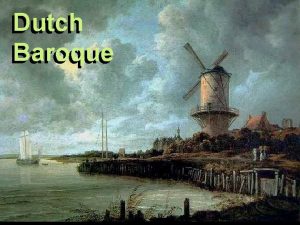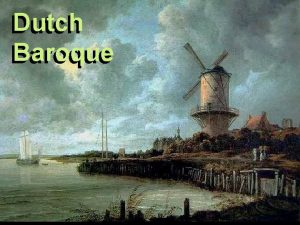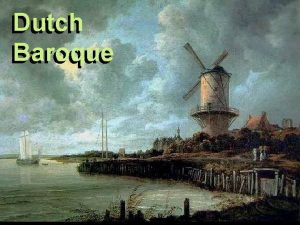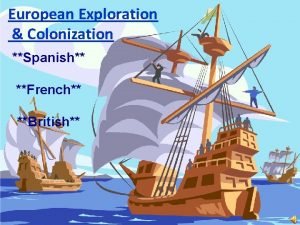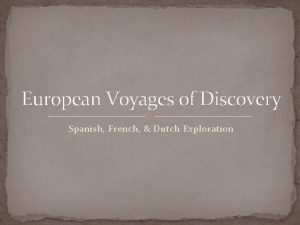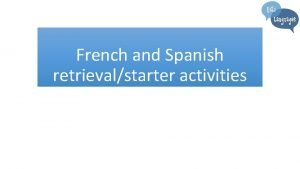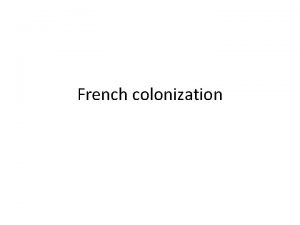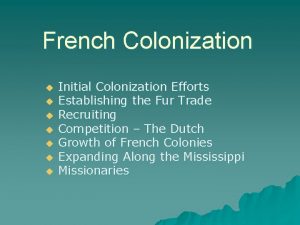Early European Colonization The Spanish Dutch French and



















- Slides: 19

Early European Colonization The Spanish, Dutch, French, and British in America

European and Native American Contact Comparative Populations in 1500: • Europe- 75 million • The Americas (North and South)100 million • U. S. and Canada- 10 million The Taínos were the first Native Americans to encounter European explorers

Why were the first explorers sailing west?

Europeans Arrive in the New World • The arrival of Christopher Columbus in the Americas marked the meeting of previously separate biological worlds.

The Columbian Exchange

The Columbian Exchange - Plants From the Americas to Europe: Beans Bell and hot peppers Blueberry Cranberry Maize (corn) Pineapple Pumpkin Squash Sweet potato Tobacco Tomato White potato From Europe to the Americas: Apple Beet Cabbage Carrot Celery Cucumber Eggplant Grapefruit Lemon Plum Olive Sugarcane

Other Exchanges From the Americas to Europe: From Europe to the Americas: Medicines/drugs: - novocaine - quinine - cocaine Diseases: - syphillis Animals: - pigs - goats - horses - cattle - sheep Diseases: - measles - chickenpox - smallpox - whooping cough

Characteristics of Colonization Spain • Motivated by desire for conquest and colonization • Based on Treaty of Tordesillas and papal line of demarcation • Conquests of the conquistadores • Native American enslavement via encomienda system (grants of lands and Indians to Spaniards) • Imported slave labor from Africa • Intermarriage with natives (more than any other Europeans) • Extensive missionary efforts (instructed by Isabella to convert the natives)

Conquistadors praying before a battle

Impact of Contact on Europe Daniel Morgan's Rifle Company as they appeared at the siege of Boston 1775 complete with Indian moccasins and war paint. • Gold and silver from Central and South America enriched European monarchies and stimulated trade and industry. • Europeans adopted Indian clothing, such as wearing moccasins, snowshoes, ponchos, and parkas. • Europeans began to use canoes and hammocks. • Indian names entered English usage.

Impact of Contact on the Americas The introduction of horses made hunting buffalo much easier for the Plains Indians • Indian lands shrank. • Indians used European knives and guns to improve hunting. • Horses gave the Plains Indians mobility to hunt buffalo and to raid settlements. • Iron pots replaced pottery and baskets. • Metal fish hooks enhanced catches.

A Final Note… • Native Americans borrowed selectively from the Europeans, but Indian cultures persisted. Material and economic incentives and the need for alliances against other tribes may have lured Indians to change their ways, but they never adopted European political and social customs, and rarely religious values or traditions.

Timeline • • • • 1492 - Columbus's first voyage to America 1494 - Treaty of Tordesillas between Spain and Portugal 1497 to 98 - Voyage of John Cabot 1513 to 1521 - Ponce de Leon explores Florida 1519 to 1522 - Cortez conquers Mexico for Spain 1519 to 21 - Magellan circumnavigates the globe 1532 - Pizarro crushes Incas 1534 - Cartier journeys up the St. Lawrence River 1539 to 1542 - De Soto explores the Southeast and discovers Mississippi River 1540 to 1542 - Coronado explores present-day Southwest 1565 - St. Augustine founded by Spanish 1680 - Pope’s Rebellion in New Mexico 1680 s- La Salle (French) expedition down Mississippi River



Main Ideas • Motives and methods of colonization: Spain, France, and Britain • Push-Pull factors bringing colonists to the New World • Cultural differences between Americans and Europeans • Impact of Europeans’ and Native Americans’ culture

Characteristics of Colonization Netherlands Spain • Motivated by desire to colonize and to exploit the lucrative fur trade • Established New Amsterdam on Manhattan Island • Emigration was limited • Colony suffered many attacks by Native Americans • Dutch government hired Henry Hudson, an experienced English seaman, to seek a northwest passage • In 1609, Hudson sailed up a broad river and established Dutch claims • A private joint-stock company, the Dutch West India Company, was given the privilege of taking control of the region for economic gain • Motivated by desire for conquest and colonization • Based on Treaty of Tordesillas and papal line of demarcation • Conquests of the conquistadores • Native American enslavement via encomienda system (grants of lands and Indians to Spaniards) • Imported slave labor from Africa (asiento system) • Intermarriage with natives (more than any other Europeans) • Extensive missionary efforts (instructed by Isabella to convert the natives)

Characteristics of Colonization Great Britain • Colonized for a variety of reasons: to relieve overcrowding, do missionary work, to remove themselves from the watchful eyes of the English government and Church of England, for adventure • Imported slave labor from Africa • Developed exclusively European communities France • Limited colonization • Imported slave labor from Africa into the Caribbean • Efforts to develop trade relations with natives • Extensive missionary efforts by the Jesuits • Samuel de Champlain established France’s first permanent settlement- Quebec • Louis Jolliet and Father Jacque Marquette explored the Mississippi River • Robert de La Salle explored the Mississippi basin, which he named Louisiana

Jesuit Missionary in New France To make a Christian out of a barbarian is not the work of a day…A great step is gained when one has learned to know those with whom he has to deal; has penetrated their thoughts; has adapted himself to their language, their customs, and their manner of living; and when necessary, has been a barbarian with them, in order to win them over to Jesus Christ. Jamestown was established by the Virginia Company of London as "James Fort" on May 14, 1607. It was the first permanent English settlement following several earlier failed attempts, including the Lost Colony of Roanoke. It would serve as capital of the colony for 83 years (from 1616 until 1699).
 Early european exploration and colonization resulted in
Early european exploration and colonization resulted in English territories in france
English territories in france After 1880 european colonization was motivated by the
After 1880 european colonization was motivated by the Kalumbiga kahulugan
Kalumbiga kahulugan French colonization apush
French colonization apush Spanish colonization of the americas
Spanish colonization of the americas Glory in spanish colonization
Glory in spanish colonization 3 g's spanish colonization
3 g's spanish colonization Early cpr and early defibrillation can: *
Early cpr and early defibrillation can: * Cycle of conquest and colonization
Cycle of conquest and colonization The mexican empresario system contributed to
The mexican empresario system contributed to Unit 2 exploration and georgia colonization
Unit 2 exploration and georgia colonization Unit 1 exploration and colonization
Unit 1 exploration and colonization Reason for colonization
Reason for colonization Columbian exchange
Columbian exchange Language in africa
Language in africa Colonization
Colonization Wilson whap
Wilson whap Colonization acrostic poem
Colonization acrostic poem Colonization defenition
Colonization defenition
